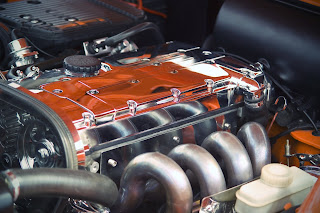Fuel
Injection is a method or system for metering fuel into an internal combustion engine,
where the fuel is burned in air to release energy in the form of energy, which
is then converted into mechanical work by engine based on the gas laws. In
modern automotive applications, the fuel metering task is the only one of
several functions performed by an engine management system.
For
the gasoline engines, carburetors were the predominant method to meter the fuel
prior to the widespread use of Electronic
Fuel Injection (EFI). However, a wide variety of injection schemes have
existed since the earliest usage of the internal combustion engine.
One
major distinction between the carburetor and fuel injection system is that the
fuel injection atomizes the fuel by forcibly pumping it through a small nozzle
under high pressure, whereas carburetor relies on the modest air pressure
created by intake air rushing through it to add the fuel to the airstream.
Another
notable difference is that a carburetor performs several important functions in
one single component: it measures engine load, calculates the amount of fuel
needed, and adds the required fuel to the airstream. With fuel injection
system, these functions are performed by different subsystems and components.
This means that each subsystem can be specialized and optimized for its particular
role, which brings a number of important performance benefits compared to the
compromise solution offered by carburetors.
Carburetors
do have some advantages over fuel injection: lower cost and lower complexity.
Prior to 1980s, nearly all automotive gasoline engines used carburetors. However,
carburetors are simply not accurate enough to deliver the performance (particularly
with respect to the emission) that is major concern today. Since 1990, almost
all gasoline passengers car sold in developed markets like USA, Europe and
Japan use Electronic Fuel Injection (EFI).
Objectives of Fuel Injection
System (FI):
The
functional objective of fuel injection system may vary according to the
requirements. All share the central task of supplying the fuel to the
combustion process, but it is a design decision how a particular system will be
optimized. There are several competing objectives such as:
·
Power output,
·
Fuel efficiency,
·
Emission performance,
·
Ability to accommodate alternative
fuels,
·
Durability and reliability,
·
Drive ability and smooth
operation,
·
Initial cost,
·
Maintenance cost,
·
Diagnostic cost,
·
Range of environmental operation.
Certain
combination of these goals are conflicting, and it is impractical for a single
engine control system to fully optimize all criteria simultaneously. In
practice, automotive engineers strive to best satisfy a customer’s need in a
competitive manner. The modern digital EFI system is far more capable at optimizing
these competing objectives than a regular carburetor.
Types of Fuel Injection System:
Fuel
injection system can be generally divided into two general categories, as
follows:
1. Air
injection,
2. Air-less,
or solid, or mechanical injection.
I.
Air
Injection
It was first developed by Rudlof Diesel. The
arrangement of the system is shown in figure given below:
In this system, air and fuel both are both injected
into the cylinder during the supply of the fuel. The required pressure of the
air for injecting the fuel is about 70 bar or higher.
A fuel pump is driven by the engine itself. A cam
shaft operates the fuel pump through a cam and the power required to rotate the
cam shaft is taken from the main shaft of the engine (Crankshaft) with the help
of gears and discharges a fixed amount of fuel into the injection valve. The
injection valve is mechanically driven and high pressure air drives the fuel
chars and some air in the combustion chamber. The amount of fuel delivered is
under the control of oil pump suction valve, which is operated by governor.
The air pressure is raised to 70 bar by a three
stage compressor providing intercooling. The compressor is also operated by the
engine. The high pressure air projects the fuel into the combustion chamber and
atomises it.
This type of system is rarely used nowadays in
diesel engine. The advantages and disadvantages of this system is listed below:
Advantages:
·
It provides
better automization and distribution of fuel,
·
As the
combustion is more complete, the BMEP is higher than with other types of
injection system,
·
It allows to use
the inferior fuels.
Disadvantages:
·
It requires
complicated mechanism to run the compressor,
·
The weight of
the engine increases,
·
Part of the
power is used to drive the compressor and so the BHP of the engine is reduced.
II.
Air less, or Solid, or Mechanical injection system
In this system, fuel is supplied at a very high
pressure at about 150 bar from the fuel pump to the fuel injector from where it
is injected to the combustion chamber with the help of injector. The main parts
of this system are fuel pump and fuel injector. The fuel pump is operated with
the help of cam which is mounted on the cam shaft. The power required to
operate the cam is taken from the engine crankshaft. Depending upon the
location of the fuel pumps and fuel injectors, and upon the method used to
meter the fuel, solid injection may further be classified as follows:
a.
Common rail
system
b.
Distributer system
c.
Unit injector
d.
Individual pump
and nozzle system



No comments:
Post a Comment